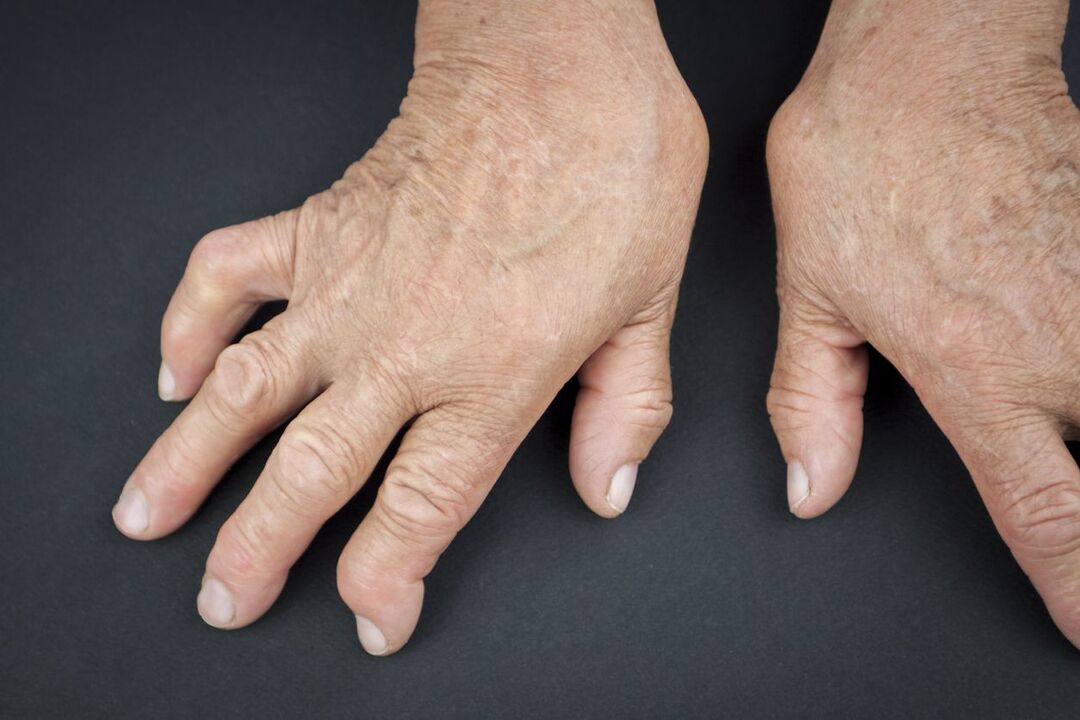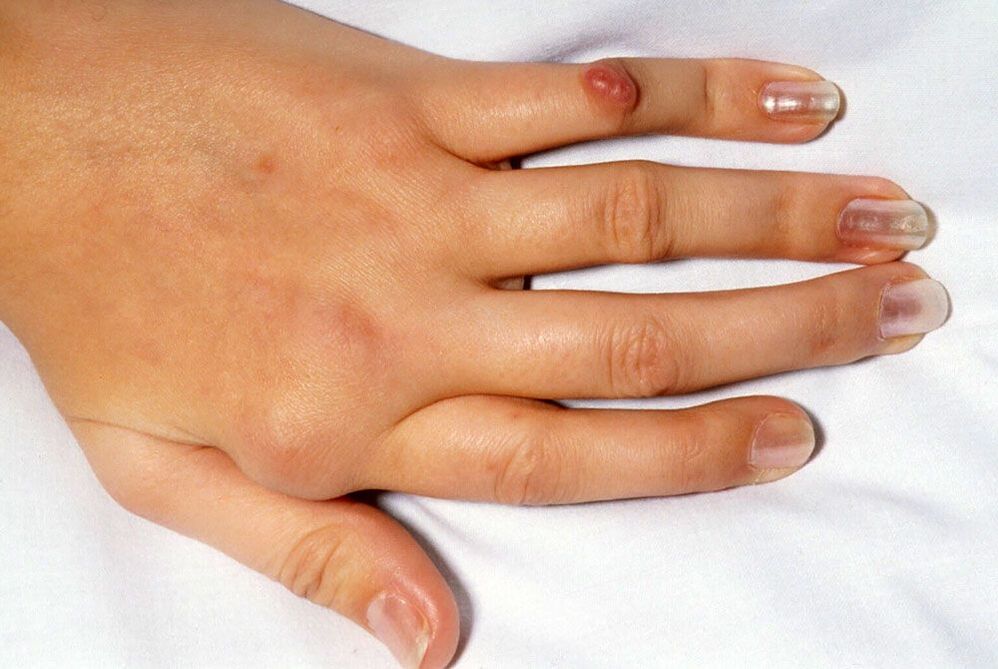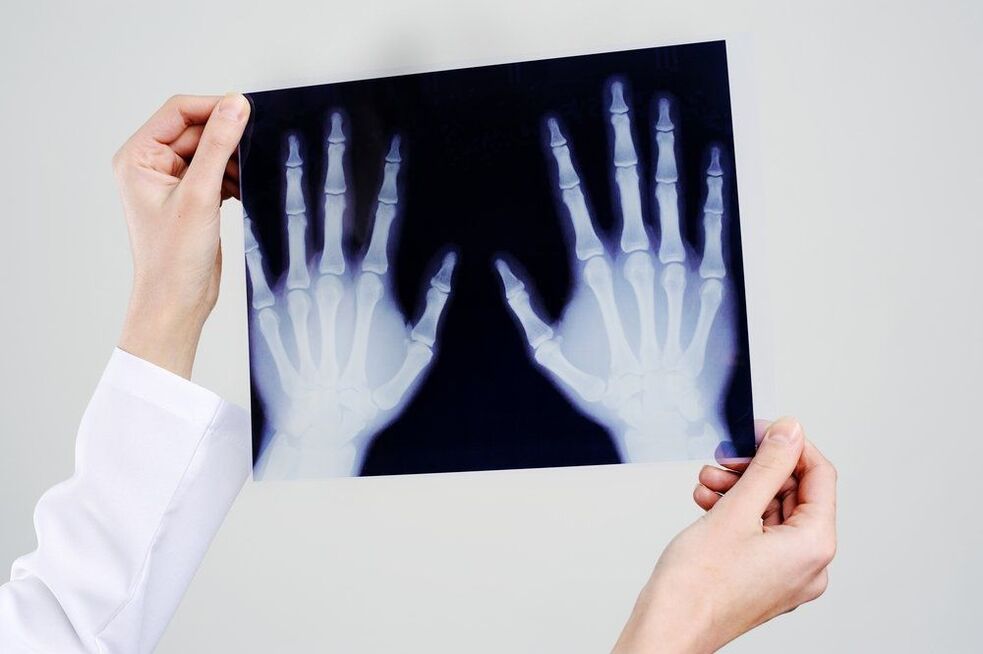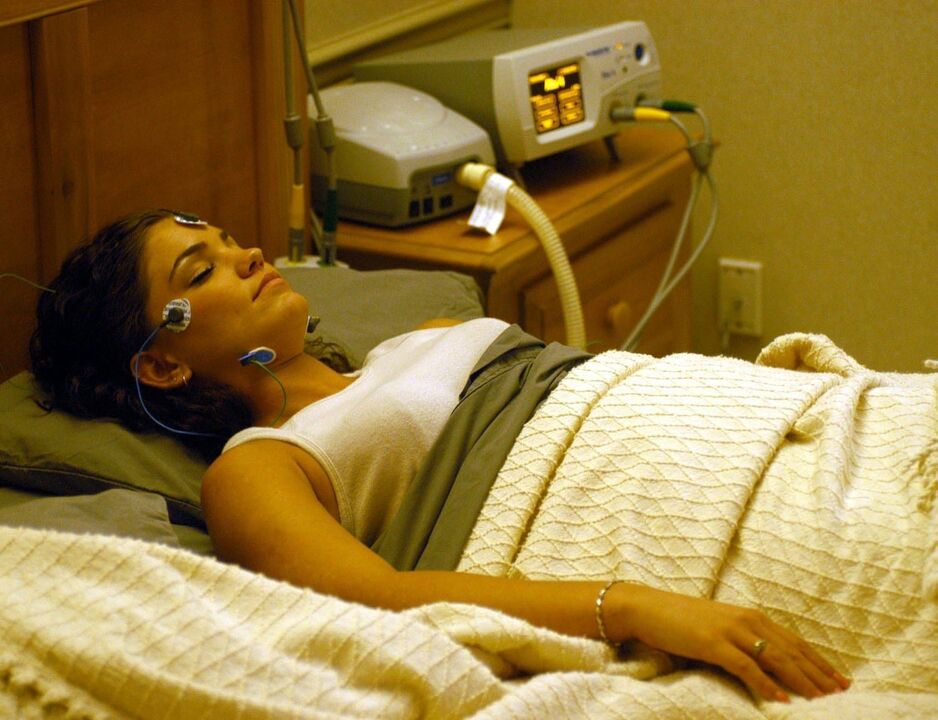
Pain in the finger joints when bending is often due to age-related changes, as well as irreversible processes in the body that cause negative manifestations and the development of an unpleasant state in the patient. Such pathology requires mandatory medical intervention, including all methods based on the cause of pain symptoms in the upper limbs.
Cause of pain
The finger should be treated if the factors causing such a problem are identified. As a rule, doctors divide pain in hand joints into 2 groups (mechanical and inflammatory).
Mechanical pain is accompanied by a local inflammatory process, mild manifestations, "erasing" the image of the disease. Quite often, patients do not pay attention to such symptoms, in contrast to pain caused by inflammation. In this case, movements are stiff in the morning, which can last more than 1 hour. The pain is slightly reduced with physical activity.
We list diseases that can cause such symptoms.
Rheumatoid arthritis
With the development of rheumatoid arthritis, small joints will be affected, but it is quite possible that internal organs and large joints can participate in the pathological process. Rheumatoid pain is accompanied by swelling and redness in the middle and index finger knuckles.
With this disease, the fingers are very painful when bent and similar symptoms appear on the second hand. The typical symptom of rheumatoid arthritis is pain that appears immediately after waking up, and the pain gradually subsides in the evening.
Psoriatic arthritis
This disease mainly affects the skin and pain occurs mainly in the distal vertebrae. With psoriatic arthritis, the fingers are severely swollen and have a bluish color. In addition, with this disease, straightening the thumb is quite difficult.
Infectious arthritis
With septic arthritis, there may be no systemic disorder at all, but it is characterized by the appearance of acute pain when bending the finger, which can last from 2-3 hours to 2-3 days. Sometimes there is a feeling of chills and increased body temperature.
Gout
This disease is the most common, but in most cases, patients completely unexpectedly find out the real reason why the finger joints hurt when bending, after clarifying the diagnosis. Usually the disease occurs in people over 50 years old.

The main reason why gout progresses is a disorder of uric acid metabolism, which is quite difficult to remove from the body, being deposited in cartilage and joints, seriously hindering their normal functioning. Typical signs of gout include burning and severe pain.
Osteoarthritis
Among the most common reasons leading to the development of osteoarthritis are genetic factors, as well as disorders of metabolic processes in the body, activities related to increased physical activity, v. v. In most cases, osteoarthritis that occurs in adult women is caused by hormonal changes.
A characteristic symptom of the disease, in addition to severe pain in the joints of the hands, is the appearance of swelling and nodules under the skin, causing deformation of the fingers and thickening of their middle part.
Narrow tendonitis
This pathological process can have symptoms similar to arthrosis and arthritis, so X-ray examination is required to clarify the diagnosis. Clinical manifestations are quite typical: the patient has pain when straightening and bending the hand, and in some cases, the palm of the hand clenched can get stuck. In addition, stretching the fingers is accompanied by characteristic clicking sounds.
Rheumatoid arthritis
If pain appears in the thumb joint, then most likely, such a condition may indicate rhizarthrosis, which is manifested by intoxication, previous infections and various types of injuries.

During the initial examination of the patient, the location of the pain is determined, the pain increases under specific loads (turning the key, turning the door handle, opening the screw cap, etc. ). In the early stages of the development of the disease, the fingers on the hand hurt only when bent after physical exertion, but the progression of rhizarthrosis leads to pain that begins to bother the patient even at rest. Gradually, joint deformity occurs with limited mobility.
In addition to all of the above diseases, the development of carpal tunnel syndrome, which is often diagnosed in young patients, can lead to unpleasant sensations in the thumb or index finger area. This is due to sitting for a long time in front of the computer, during which time the ulnar nerve is compressed, which in turn leads to pain in the fingers.
Pathological symptoms
Serious signs of the presence of the disease that can lead to a number of negative consequences are:
- nodular tumor in the tendon area;
- fingers creak when moved;
- pain when palpating the hand;
- throbbing, aching pain and impaired fine motor skills;
- compression in the bends of the fingers and hyperemia in the inflamed area;
- inability to squeeze the little finger;
- local and local increase in body temperature;
- increased night pain in the arm;
- Pay special attention if your finger suddenly becomes swollen and deformed.
If the patient detects such manifestations, urgent consultation with a doctor is required, who will conduct diagnostic measures and prescribe complex therapy to reduce pain symptoms and the inflammatory process.
Diagnostic method
Patients who experience hand pain, especially after sleep, must undergo a course of treatment, but only after clarifying the cause of the development of the pathological condition.
In this case, diagnosis includes the following methods:
X-ray
The most informative way to identify tumor-like tumors, various injuries and inflammatory processes in the joints of the fingers and hands is X-ray examination.

Despite the high effectiveness of radiography, it has a significant drawback - the inability to assess the condition of soft tissues.
supersonic
Using ultrasound, the presence of an inflammatory process in tissues is determined and the consequences of joint injury are determined. This procedure is most effective for synovitis, arthritis, tendinitis, bursitis, and arthritis. In cases where the middle finger is numb and painful, an ultrasound examination of the blood vessels can be performed to determine blood circulation disorders in the upper limb.
CT scan
To obtain a more accurate picture of the pathology of bone and joint tissue, a CT scan should be performed, which takes 5-7 minutes and is well tolerated by the patient. The difference between computed tomography and radiography is that the information obtained is displayed directly on the control screen, which allows you to obtain more reliable information.
ECG
A popular and highly effective examination method is electroacoustic recording, which has been used in medicine relatively recently. This test can detect early damage to the spinal region responsible for the function of the upper limbs, including the fingers.
MRI
Magnetic resonance imaging is considered an informative and accurate study, therefore it is often used in the diagnosis of various diseases, including joints. The pathological process is determined using electromagnetic waves, forming an image of the tissue, location and degree of development of the inflammatory process.
In addition, blood tests (clinical and biochemical), urine tests for the presence of blood and proteins, as well as arthrocentesis to detect persistent pain in the finger.
Important! It must be taken into account that fingers can hurt for many reasons, however, only a highly qualified specialist can accurately diagnose the disease and prescribe individual pain treatment.
Treatment
If painful symptoms occur, the main therapeutic measures should be aimed at eliminating the cause of development of the pathological process.
Complex therapy includes both drug treatment and treatment with folk remedies.
Treatment medicine
To ease the pathological process, the doctor prescribes the patient a course of nonsteroidal anti-inflammatory drugs (NSAIDs), which, in addition to reducing inflammation, relieve pain symptoms and reduce tissue swelling.
For osteoarthritis, long-term use of chondroprotectants is recommended to nourish the cartilage and prevent its further destruction. These medications help prevent the disease from recurring.
In cases where the pain in the finger is unbearable and the inflammatory process is in an advanced stage, glucocorticosteroids will be prescribed. They quickly reduce inflammatory symptoms and regulate metabolic processes in the body, thereby accelerating tissue regeneration.
If the main cause of pain in the finger area is a bacterial infection, the doctor will prescribe antibiotics and antibacterial drugs, based on the severity of the symptoms and the body's sensitivity to the infection. that group of drugs.
Important! You should not self-treat as it may cause allergies and side effects. At the beginning of treatment, it is necessary to restore damaged joints. And only during the calm period should auxiliary methods be used (physical therapy, hand massage, gymnastics, etc. ).
Physical therapy
Pain in the hand joints indicates a violation of the entire function of the body and, in particular, the development of a degenerative-dystrophic process. That is why it is first necessary to limit physical activity and reduce physical stress on the joints.
Physiotherapeutic measures include resonance therapy, electrosleep, and electrophoresis with the addition of novocaine. In addition, during remission, therapeutic exercises, the use of mud, hydrogen sulfide and radon baths as well as massage, including manual massage, have a positive effect.

Diet
Proper nutrition is of no small importance in preventing pain from appearing, because the body must receive a sufficient amount of trace elements such as potassium, magnesium, calcium, phosphorus, iron and vitamins, mainly through food. .
The product helps reduce finger joint pain when bending:
- Fish oil and flaxseed oil. These products contain a large amount of omega-3 fatty acids, which improve the condition of the vascular system and participate in the normalization of fat metabolism.
- Apple cider vinegar, as it enhances salt elimination and participates in the alkalization of the blood.
- Radishes, lettuce and nuts.
- Egg yolks, juice and pomegranate.
- Blackcurrants and figs.
- Ginger and cauliflower.
- Low-calorie cheese and olive oil.
It is necessary to limit (and in some cases completely exclude from the diet) high-fat dairy products, sweet and high-calorie foods. Smoked meat, alcoholic beverages, coffee, strong tea as well as products containing oxalic acid.
Folk remedies
At the initial stages of the disease, pain can be treated using traditional medicine, for example, using kefir compresses and chalk, diluted to a pasty state. Boiling oatmeal first and letting it cool a bit has the same effect.
You can prepare a cream for hand massage from an equal amount of crushed bay leaves and juniper pine with the addition of softened butter to this powder. After thoroughly mixing the ingredients, the ointment can be used for its intended purpose.
In case of exacerbation of pain symptoms, it is recommended to mix 1 tbsp. a spoonful of olive oil with 5 drops of garlic juice, then drink the prepared mixture in the morning, 30 minutes before breakfast. The procedure should be repeated in 3-4 days.
Sudden, severe pain in the finger interferes with the performance of daily tasks, causing unbearable suffering for the patient. Such manifestations should not be ignored as they can indicate some serious diseases that can cause painful symptoms.
Only early diagnosis and timely intervention by an experienced doctor can determine the cause of the disease, and on that basis, the doctor decides on the treatment method and method to obtain the most positive results. . With timely intervention, the prognosis for full recovery is favorable.















































